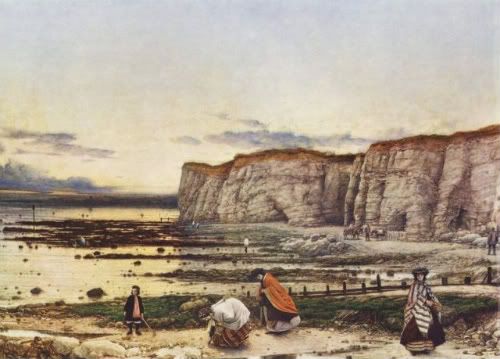"There is grandeur in this view of life, with its several powers, having been originally breathed into a few forms or into one; and that, whilst this planet has gone cycling on according to the fixed law of gravity, from so simple a beginning endless forms most beautiful and most wonderful have been, and are being, evolved." - Charles Darwin, The Origin of the Species
I ran across the website for Endless Forms: Charles Darwin, Natural Science and the Arts while doing a search to see what connections there might have been between Charles Darwin and the Pre-Raphaelites. I saw Creation, a very interesting film about Darwin a few weeks ago. The film starred Paul Bettany and I really enjoyed it. Very nicely done, in my opinion, though I know that many may have been disappointed by it. The film focused more on Darwin's relationship with his daughter than it did on science, but the movie captured the Victorian era so well, and I loved the Gothic way the story was told, so I would recommend it. At any rate, after seeing the film it occurred to me that Darwin was a contemporary of the Pre-Raphaelites, and I wondered what they had thought of them.
I always knew there was some disagreement between the Pre-Raphaelites and Darwin. Ruskin (who else?), was the most vocal critic I could find. He disliked Darwin because he felt his science robbed the world of wonder, mystery and beauty. He wrote frequently on the topic of natural selection (or rather, Ruskin's own highly amusing version of it). In response to Darwin's suggestion that "the final end of the whole flower....is the production of the seed" Ruskin argued that "the flower exists for its own sake...not for the fruit's sake." Oh well. There was no pleasing Ruskin - just ask Effie...
But what of the other Pre-Raphaelites?
But what of the other Pre-Raphaelites?
One of the more direct artistic Pre-Raphaelite responses to Darwin's work that I could find was this painting by William Dyce, which was originally part of the "Endless Forms" exhibition. The picture features the artist's family gathering fossils in Pegwell Bay, near Kent. The painting, which is held today by the Tate Gallery, uses the tail of Donati's comet to cast an ominous and uncertain mood over the scene (the comet's tail is supposed to be "barely visible" in the center of the painting - I think it's one of the white spots near the top-middle area of the picture, but I can't be sure). Dyce was a devout Anglican, so the inclusion of the comet - which, conveniently, was not due to reappear for 2,000 years - is rich with symbolism.
Be sure to check out the virtual exhibition of "Endless Forms" online. It gives an interesting overview of artistic responses to Darwin, from early natural history drawings through to the Impressionists.
image courtesy Wikimedia



10 comments:
Though not by the PRB I always thought Landseer's Man Proposes, God Disposes was a deep comment on science.
Ah, that is one freaky painting! And kind of weird, since the rest of Landseer's paintings are downright dull. I found it surprising he could paint the polar bears as such ferocious creatures, when he drew a multitude of lounging lapdogs for the rest of his pictures. A bit over the top, if you ask me (gotta love the one bear with the human rib dangling from its maw), but perhaps I just don't get it!
I just noticed that Landseer's painting is on exhibition at the Musée national des beaux-arts du Québec until September 6, 2010. I wish I could make it! It would be interesting to see it in person. The exhibition is entitled "Paintings from the Reign of Victoria."
I never made the connection before about the Victorian's passion for collecting fossils and the responses to Darwin's work.
The painting brought back memories of fossil hunting on the Dorset coast where it is hard not to find a rock without a fossil of some sort.
interesting connections here. i want to see Creation as well.
This is a wonderful painting you have described, seemingly, much ahead of its time.
Timing is everything! Look at "Charles Darwin and The Art of Evolution Conference", 9-11th Sep 2010 at the Art Gallery of New South Wales:
http://melbourneartnetwork.com.au/2010/07/26/conference-charles-darwin-and-the-art-of-evolution/
The papers "will explore the impact of Charles Darwin’s theories upon art and other visual cultures and the ways they, in turn, illuminate intriguing dimensions of his theories".
Thank you for the link, Hels! It looks like it will be a great conference. Are you planning to attend?
Good morning, Margaret!
How nice that you came by to visit! I remember "meeting" your early in the year or late last year.....how is school? Your post is fabulous, beautifully written with such a keen critique and look at his beautiful art...I love this period of art and although I am an amateur in every sense of the word, I so appreciate anyone who can imagine what the artists actually wanted to convey in their work. I am married to a historian, but his history knowledge usually doesn't extend to art but rather politics and religion, another "out of my league" area! Very lovely dearest, and you are welcome to my silly little world anytime you need to "get away"!!!
Anita
Thank you, Anita!
Post a Comment